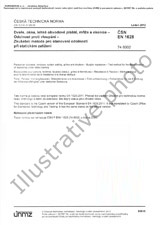We need your consent to use the individual data so that you can see information about your interests, among other things. Click "OK" to give your consent.
ČSN EN ISO 19901-10 (450027)
Petroleum and natural gas industries - Specific requirements for offshore structures - Part 10: Marine geophysical investigations
Translate name
STANDARD published on 1.8.2022
The information about the standard:
Designation standards: ČSN EN ISO 19901-10
Classification mark: 450027
Catalog number: 514777
Publication date standards: 1.8.2022
SKU: NS-1067972
The number of pages: 96
Approximate weight : 319 g (0.70 lbs)
Country: Czech technical standard
Category: Technical standards ČSN
The category - similar standards:
Annotation of standard text ČSN EN ISO 19901-10 (450027):
This document provides requirements and guidelines for marine geophysical investigations. It is applicable to operators/end users, contractors and public and regulatory authorities concerned with marine site investigations for offshore structures for petroleum and natural gas industries.
This document provides requirements, specifications, and guidance for:
- a) objectives, planning, and quality management;
- b) positioning;
- c) seafloor mapping, including instrumentation and acquisition parameters, acquisition methods, and deliverables;
- d) sub-seafloor mapping, including seismic instrumentation and acquisition parameters, and non-seismic-reflection methods;
- e) reporting;
- f) data integration, interpretation, and investigation of geohazards.
This document is applicable to investigation of the seafloor and the sub-seafloor, from shallow coastal waters to water depths of 3 000 m and more. It provides guidance for the integration of the results from marine soil investigations and marine geophysical investigations with other relevant datasets.
NOTE 1 - The depth of interest for sub-seafloor mapping depends on the objectives of the investigation. For offshore construction, the depths of investigation are typically in the range 1 m below seafloor to 200 m below seafloor. Some methods for sub-seafloor mapping can also achieve much greater investigation depths, for example for assessing geohazards for hydrocarbon well drilling.
There is a fundamental difference between seafloor mapping and sub-seafloor mapping: seafloor signal resolution can be specified, while sub-seafloor signal resolution and penetration cannot. This document therefore contains requirements for the use of certain techniques for certain types of seafloor mapping and sub-seafloor mapping (similarly, requirements are given for certain aspects of data processing). If other techniques can be shown to obtain the same information, with the same or better resolution and accuracy, then those techniques may be used.
Mapping of pre-drilling well-site geohazards beneath the seafloor is part of the scope of this document.
NOTE 2 - This implies depths of investigation that are typically 200 m below the first pressure-containment casing string or 1 000 m below the seafloor, whichever is greatest. Mapping of pre-drilling well-site geohazards is therefore the deepest type of investigation covered by this document.
In this document, positioning information relates only to the positioning of survey platforms, sources and receivers. The processes used to determine positions of seafloor and sub-seafloor data points are not covered in this document.
Guidance only is given in this document for the use of marine shear waves (A.8.3.3), marine surface waves (A.8.3.4), electrical resistivity imaging (A.8.3.5) and electromagnetic imaging (A.8.3.6)
Preview of the standard ČSN EN ISO 19901-10 (450027)
We recommend:
Technical standards updating
Do you want to make sure you use only the valid technical standards?
We can offer you a solution which will provide you a monthly overview concerning the updating of standards which you use.
Would you like to know more? Look at this page.




 Cookies
Cookies
